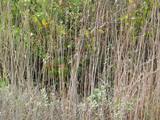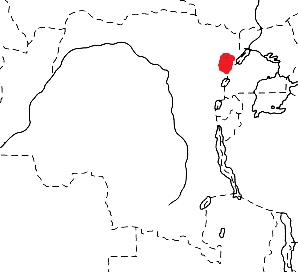Weaver species
Choose different species from drop-down list and press 'Go' button. See Full species list.Yellow-legged Weaver Ploceus flavipes
IUCN: Vulnerable Discovery: 108Categories: black, IUCN,
News items about species
Discovery
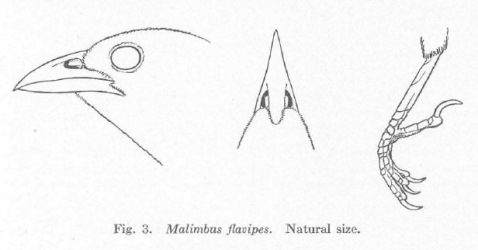
figure from Chapin 1916a 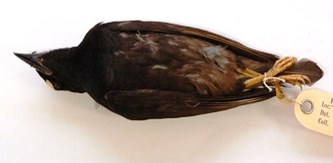
type specimen 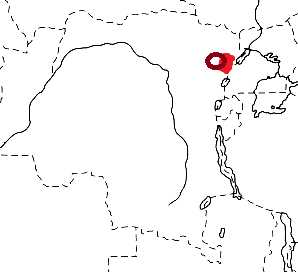
distribution, type locality circled IntroductionThe Yellow-legged Weaver was collected and formally described by James Paul Chapin, an American ornithologist.Chapin is one of the highest-regarded ornithologists of the twentieth century. Chapin and Herbert Lang led an expedition to conduct a biological survey of the Belgian Congo between 1909 and 1915. Chapin published many papers with new bird species descriptions, and eventually summarised all bird data in several volumes, "The Birds of the Belgian Congo". Chapin was based at Avakubi for much of his time in DRCongo, but only in 1913 one of his hunters brought him a single specimen of the Yellow-legged Weaver from the forest. The female specimen contained small caterpillars in the stomach. Several more specimens were collected over the next few decades, but only in 1960 was the first adult male specimen described. Chapin included a line drawing of the head, bill and leg of the Yellow-legged Weaver type. The Yellow-legged Weaver was first fully illustrated by Mackworth 1973a. Scientific citationMalimbus flavipes Chapin 1916a, Bull. Am. Mus. Nat. Hist. 35 p.27, Avakubi, Zaire.Meaning of namesflavipes, Latin: flavus, golden-yellow; pes, the foot.First English nameYellow-legged Malimbe (Sclater 1930a).Alternate namesYellow-footed Weaver, Yellow-legged Malimbe.CollectorChapin's hunter.Date collected20 Sep 1913.Locality collectedAvakubi, Ituri District, Belgian Congo.Type specimensThe type is in the American Museum of Natural History (AMNH 162602). |
The above is based on Weaver Wednesday 2, a weekly series about the discovery of each weaver species.
This species text first appeared as
Weaver Wednesday [225] - Discovery [108]: Yellow-legged Weaver on 2016-10-05
1. Basic biology
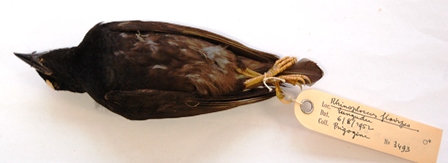
The belly and undertail-coverts of the Yellow-legged Weaver are dark brown, and the sexes are similar. Distribution.
The Yellow-legged Weaver is restricted to lowland forest in eastern DR Congo (see map below, based on Birds of Africa). Only 9 specimens are known, the last from 1959; two sight records from Okapi Faunal Reserve (1990 and 1994).
There are no subspecies. The Yellow-legged Weaver is rare, and very poorly known. It has been suggested that it could represent occasional hybrids, but recent DNA work suggests that it is a valid species (presented at the 2012 PAOC). Habitat. The Yellow-legged Weaver inhabits the canopy of dense lowland forest. Food. The Yellow-legged Weaver probably feeds on insects, and small caterpillars have been recorded in its diet. Breeding. Nothing is known about breeding in the Yellow-legged Weaver. |
The above is based on Weaver Wednesday, a weekly series about weaver species.
This species text first appeared as
Weaver Wednesday [111]: Yellow-legged Weaver on 2014-07-30
2. Breeding facts
| Pair bond no information Breeding season Two specimens in breeding condition in Sept Nest site no information Nest building no information Colony size no information Clutch size no information Egg colour no information Egg size no information Incubation no information Chicks and nestling period no information |
Breeding information based on Handbook of the Birds of the World, Vol. 15.
3. Photos of Weaver Nests
No records yet - be the first to submit a PHOWN record!See PHOWN summary page for this species here.
PHOWN (Photos of Weaver Nests) provides valuable info on breeding distribution and colony sizes of weavers.
You can contribute by registering and submitting photos at Virtual Museum webpage.
4. Breeding distribution
Google map showing distribution (For species with small ranges you need to zoom in at the correct area to see the range):
yellow blob - range of weaver species; read more about this here.
![]() - PHOWN records with photos
- PHOWN records with photos
![]() - PHOWN records with no photos (Nest Record Cards, other records)
- PHOWN records with no photos (Nest Record Cards, other records)
![]() - Birdpix records
- Birdpix records
![]() - comments on out of range records, or interesting records
- comments on out of range records, or interesting records
![]() - type locality
- type locality
CLICK on the marker on the map to see individual record details.
5. Range changes
Not South African speciesThe above is based on Weaver Wednesday 3, a weekly series about range changes in South African weaver species.
This species text first appeared as
n/a








